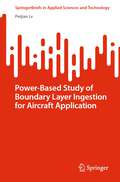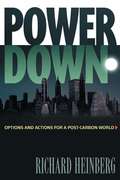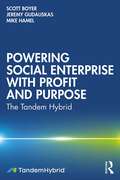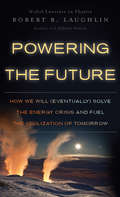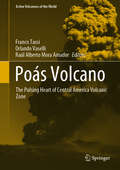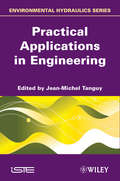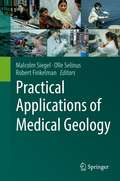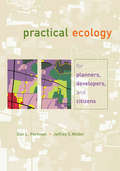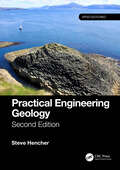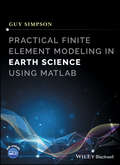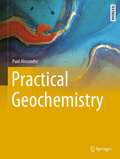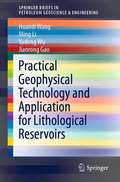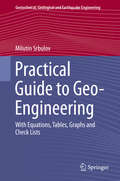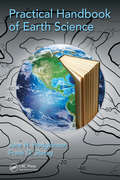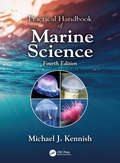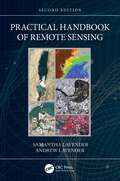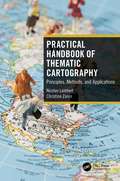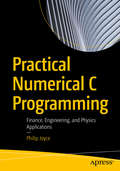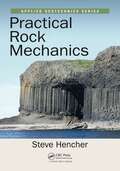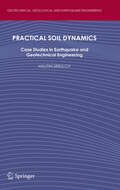- Table View
- List View
Power-Based Study of Boundary Layer Ingestion for Aircraft Application (SpringerBriefs in Applied Sciences and Technology)
by Peijian LvThis book presents research on Boundary Layer Ingestion (BLI). BLI is an aircraft-engine integration technique that aims at integrating the aircraft and the propulsion system such that the overall aircraft fuel consumption can be reduced. In this research, theoretical analysis suggests that the minimization of total power consumption should be used as a design criterion for aircraft utilizing BLI rather than focusing on the minimization of drag. Numerical simulations are performed, and the simulation results are processed using the PBM to support the theoretical analysis. Furthermore, an experimental study is carried out with a focus on the power conversion processes involved for a propulsor operating in the wake. Stereoscopic PIV is employed in order to visualize the flow and understand the physics. The so-called Power-based Method is used to quantify the power conversion mechanisms. The results prove that the dominant mechanism responsible for the efficiency enhancement is due to the utilization of body wake energy by the wake ingesting propeller. In short, the importance of wake energy flow rate in understanding the BLI phenomenon is highlighted. This book will be useful for researchers in the field of aircraft propulsion, aircraft aerodynamics, and airframe propulsion integration.
Powerdown
by Richard HeinbergIf the US continues with its current policies, the next decades will be marked by war, economic collapse, and environmental catastrophe. Resource depletion and population pressures are about to catch up with us, and no one is prepared. The political elites, especially in the US, are incapable of dealing with the situation and have in mind a punishing game of "Last One Standing."The alternative is "Powerdown," a strategy that will require tremendous effort and economic sacrifice in order to reduce per-capita resource usage in wealthy countries, develop alternative energy sources, distribute resources more equitably, and reduce the human population humanely but systematically over time. While civil society organizations push for a mild version of this, the vast majority of the world's people are in the dark, not understanding the challenges ahead, nor the options realistically available.Powerdown speaks frankly to these dilemmas. Avoiding cynicism and despair, it begins with an overview of the likely impacts of oil and natural gas depletion and then outlines four options for industrial societies during the next decades:Last One Standing: the path of competition for remaining resources;Powerdown: the path of cooperation, conservation and sharing;Waiting for a Magic Elixir: wishful thinking, false hopes, and denial;Building Lifeboats: the path of community solidarity and preservation.Finally, the book explores how three important groups within global society--the power elites, the opposition to the elites (the antiwar and antiglobalization movements, et al: the "Other Superpower"), and ordinary people--are likely to respond to these four options. Timely, accessible and eloquent, Powerdown is crucial reading for our times.Richard Heinberg is an award-winning author of five previous books, including The Party's Over: Oil, War and the Fate of Industrial Societies. A member of the Core Faculty of New College of California, he lives in Santa Rosa, California.
Powerful Earthquakes
by Greg RozaLearn more about why earthquakes happen, history of some major earthquakes, and what you can do to prepare.
Powering Social Enterprise with Profit and Purpose: The Tandem Hybrid
by Scott Boyer Jeremy Gudauskas Mike HamelTrail-blazing social entrepreneurs are tackling the world’s most pressing problems that government, business, or charity have failed to solve. They are creating businesses with a primary mission of social change. Scott Boyer is one such social entrepreneur. This 28-year veteran of Big Pharma left a six-figure salary to start OWP Pharmaceuticals and the ROW Foundation. This commercial business and non-profit organization exist in a symbiotic relationship we call a "tandem hybrid social enterprise." This model combines a multimillion dollar business with a foundation that’s on track to become the largest funder of projects serving people with epilepsy and associated psychiatric disorders in the world. The tandem hybrid incorporates the principles learned by Scott and others for building a truly unique social enterprise from the ground up; one that is: Driven by a compelling social mission Financed by commercial success Structured to retain control Scalable and sustainable for the long haul Powering Social Enterprises With Profit And Purpose offers a detailed blueprint that has proven commercially and philanthropically successful and that can be replicated in most business sectors.
Powering Social Enterprise with Profit and Purpose: The Tandem Hybrid
by Scott Boyer Jeremy Gudauskas Mike HamelTrail-blazing social entrepreneurs are tackling the world’s most pressing problems that government, business, or charity have failed to solve. They are creating businesses with a primary mission of social change. Scott Boyer is one such social entrepreneur. This 28-year veteran of Big Pharma left a six-figure salary to start OWP Pharmaceuticals and the ROW Foundation. This commercial business and non-profit organization exist in a symbiotic relationship we call a "tandem hybrid social enterprise." This model combines a multimillion dollar business with a foundation that’s on track to become the largest funder of projects serving people with epilepsy and associated psychiatric disorders in the world.The tandem hybrid incorporates the principles learned by Scott and others for building a truly unique social enterprise from the ground up; one that is: Driven by a compelling social mission Financed by commercial success Structured to retain control Scalable and sustainable for the long haul Powering Social Enterprises With Profit And Purpose offers a detailed blueprint that has proven commercially and philanthropically successful and that can be replicated in most business sectors.
Powering the Future: How We Will (Eventually) Solve the Energy Crisis and Fuel the Civilization of Tomorrow
by Robert B. LaughlinLaughlin (physics, Stanford U. and Nobel Laureate) offers a readable case for where energy will come from when the world's oil is gone. He considers the economic, ecological, and geopolitical implications of a variety of probable alternatives in a somewhat comforting upbeat tone tempered with a good amount of common sense. Some of the options he sees: solar and wind, geothermal, biofuels (such as animal waste, vegetable matter), and nuclear power. Annotation ©2011 Book News, Inc. , Portland, OR (booknews. com)
Poás Volcano: The Pulsing Heart Of Central America Volcanic Zone (Active Volcanoes of the World)
by Franco Tassi Orlando Vaselli Raúl Alberto Mora AmadorThis book provides a comprehensive description of the volcanological, petrological and geochemical features of the Poás Volcano (Costa Rica), one of the most active volcanic systems in Central America and part of the Central America Volcanic Arc (CAVA). Poás Volcano hosts a unique sulfur lake, which actually is one of the world's most acidic lakes, and has experienced molten sulfur eruptions. Past investigations, current monitoring activities and planned programs of investigation into lessening of the volcanic hazard are reported here. Specific sections of the monograph will be devoted to the impact of this volcano on the social, agricultural and industrial activities in the area. Legends and popular traditions related to this volcano will be described in the last chapter to round up a complete scientific review on this unique volcanic system.
Practical Applications in Engineering
by Jean-Michel TanguyThis series of five volumes proposes an integrated description of physical processes modeling used by scientific disciplines from meteorology to coastal morphodynamics. Volume 1 describes the physical processes and identifies the main measurement devices used to measure the main parameters that are indispensable to implement all these simulation tools. Volume 2 presents the different theories in an integrated approach: mathematical models as well as conceptual models, used by all disciplines to represent these processes. Volume 3 identifies the main numerical methods used in all these scientific fields to translate mathematical models into numerical tools. Volume 4 is composed of a series of case studies, dedicated to practical applications of these tools in engineering problems. To complete this presentation, volume 5 identifies and describes the modeling software in each discipline.
Practical Applications of Medical Geology
by Olle Selinus Robert Finkelman Malcolm SiegelThis edited volume provides a framework for integrating methods and information drawn from geological and medical sciences and provides case studies in medical geology to illustrate the usefulness of this framework for crafting environmental and public health policies related to natural materials. The relevance of medical geology research to policy decisions is a topic rarely discussed, and this volume attempts to be a unique source for researchers and policy makers in the field of medical geology in addressing this gap in practical medical geology applications. The book's four sections establish this framework in detail using risk assessment, case studies, data analyses and specific medical geology techniques. Following an introduction to medical geology in the context of risk assessment and risk management, the second section discusses specific methods used in medical geology in the categories of geoscience, biomedicine, and data sources. The third section discusses the medical geology of natural materials, energy use, and environmental and workplace impacts. This section includes specific case studies in medical geology, and describes how the methods and data from the previous section are used in a medical geology analysis. The fourth section includes a guide to the medical geology literature and provides some examples of medical geology programs in Asia and Africa.
Practical Aspects of Computational Chemistry I: An Overview of the Last Two Decades and Current Trends
by Jerzy Leszczynski Manoj K. K. ShuklaPractical Aspects of Computational Chemistry I: An Overview of the Last Two Decades and Current Trends gathers the advances made within the last 20 years by well-known experts in the area of theoretical and computational chemistry and physics. The title itself reflects the celebration of the twentieth anniversary of the “Conference on Current Trends in Computational Chemistry (CCTCC)” to which all authors have participated and contributed to its success. This volume poses (and answers) important questions of interest to the computational chemistry community and beyond. What is the historical background of the “Structural Chemistry”? Is there any way to avoid the problem of intruder state in the multi-reference formulation? What is the recent progress on multi-reference coupled cluster theory? Starting with a historical account of structural chemistry, the book focuses on the recent advances made in promising theories such as many body Brillouin-Wigner theory, multireference state-specific coupled cluster theory, relativistic effect in chemistry, linear and nonlinear optical properties of molecules, solution to Kohn-Sham problem, electronic structure of solid state materials, development of model core potential, quantum Monte Carlo method, nano and molecular electronics, dynamics of photodimerization and excited states, intermolecular interactions, hydrogen bonding and non-hydrogen bonding interactions, conformational flexibility, metal cations in zeolite catalyst and interaction of nucleic acid bases with minerals. Practical Aspects of Computational Chemistry I: An Overview of the Last Two Decades and Current Trends is aimed at theoretical and computational chemists, physical chemists, materials scientists, and particularly those who are eager to apply computational chemistry methods to problem of chemical and physical importance. This book will provide valuable information to undergraduate, graduate, and PhD students as well as to established researchers.
Practical Aspects of Computational Chemistry II
by Jerzy Leszczynski Manoj ShuklaPractical Aspects of Computational Chemistry II: An Overview of the Last Two Decades and Current Trends gathers the discussion of advances made within the last 20 years by well-known experts in the area of theoretical and computational chemistry and physics. The title reflects the celebration of the twentieth anniversary of the "Conference on Current Trends in Computational Chemistry (CCTCC)" to success of which all authors contributed. Starting with the recent development of modeling of solvation effect using the Polarizable Continuum Model (PCM) at the Coupled-Cluster level and the effects of extreme pressure on the molecular properties within the PCM framework, this volume focuses on the association/dissociation of ion pairs in binary solvent mixtures, application of graph theory to determine the all possible structures and temperature-dependent distribution of water cluster, generalized-ensemble algorithms for the complex molecular simulation, QM/MD based investigation of formation of different nanostructures under nonequilibrium conditions, quantum mechanical study of chemical reactivity of carbon nanotube, covalent functionalization of single walled-carbon nanotube, designing of functional materials, importance of long-range dispersion interaction to study nanomaterials, recent advances in QSPR/QSAR analysis of nitrocompounds, prediction of physico-chemical properties of energetic materials, electronic structure and properties of 3d transition metal dimers, the s-bond activation reactions by transition metal complexes, theoretical modeling of environmental mercury depletion reaction, organolithium chemistry and computational modeling of low-energy electron induced DNA damage. Practical Aspects of Computational Chemistry II: An Overview of the Last Two Decades and Current Trends is aimed at theoretical and computational chemists, physical chemists, materials scientists, and particularly those who are eager to apply computational chemistry methods to problems of chemical and physical importance. This book provides valuable information to undergraduate, graduate, and PhD students as well as to established researchers. Practical Aspects of Computational Chemistry II: An Overview of the Last Two Decades and Current Trends is aimed at theoretical and computational chemists, physical chemists, materials scientists, and particularly those who are eager to apply computational chemistry methods to problems of chemical and physical importance. This book provides valuable information to undergraduate, graduate, and PhD students as well as to established researchers.
Practical Ecology for Planners, Developers, and Citizens
by Dan L. Perlman Jeffrey MilderPractical Ecology for Planners, Developers, and Citizens introduces and explains key ecological concepts for planners, landscape architects, developers, and others involved in planning and building human habitats. The book is tailored to meet the needs of busy land use professionals and citizens seeking a concise yet thorough overview of ecology and its applications. It offers clear guidelines and a wealth of information on how we can protect species and ecosystems while at the same creating healthy, sustainable human communities. Throughout the book, the authors make ecological concepts accessible to readers with little or no scientific background. They present key ideas and information in simple and pragmatic terms, and provide numerous graphics to help explain important concepts. They also offer exercises for the reader to practice ecologically-based planning and design, along with a list of resources for practical information on ecology and conservation. Practical Ecology for Planners, Developers, and Citizens will raise the level of ecological understanding among land use professionals and citizens, and is an invaluable new resource for anyone concerned with human land use and its environmental impacts.
Practical Engineering Geology (Applied Geotechnics)
by Steve HencherPractical Engineering Geology provides an introduction to the way projects are managed, designed and constructed, and how the engineering geologist can contribute to cost- effective and safe project achievement. The need for a holistic view of geological materials, from soil to rock, and of geological history is emphasised. Chapters address key aspects of• Geology for engineering and ground modelling• Site investigation and testing of geological materials• Geotechnical parameters• Design of slopes, tunnels, foundations, and other engineering structures• Identifying hazards• Avoiding unexpected ground conditionsThis second edition includes a new chapter on environmental issues covering hydrogeology, considerations of climate change, earthquakes, and more. All chapters have been updated, with extensively revised figures throughout and several new case studies of unexpected ground conditions. The book will support practising engineering geologists and geotechnical engineers, as well as MSc level students of engineering geology and other geotechnical subjects.
Practical Finite Element Modeling in Earth Science using Matlab
by Guy SimpsonMathematical models have become a crucial way for the Earth scientist to understand and predict how our planet functions and evolves through time and space. The finite element method (FEM) is a remarkably flexible and powerful tool with enormous potential in the Earth Sciences. This pragmatic guide explores how a variety of different Earth science problems can be translated and solved with FEM, assuming only basic programming experience. This book begins with a general introduction to numerical modeling and includes multiple sample Matlab codes to illustrate how FEM is implemented in practice. Textboxes have been included to provide additional detail, such as specialized Matlab usage or advanced topics. Covering all the key aspects, this is essential reading for those looking to master the technique, as well as those simply seeking to increase their basic level of understanding and appreciation of FEM.
Practical Geochemistry (Springer Textbooks in Earth Sciences, Geography and Environment)
by Paul AlexandreThis book is a marked departure from typical introductory geochemistry books available: It provides a simple, straightforward, applied, and down-to-earth no-nonsense introduction to geochemistry. It is for the undergraduate students who are introduced to the subject for the first time, but also for practicing geologists who do not need the heavy-duty theory, but some clear, simple, and useful practical tips and pointers.This book, written from the point of view of a practicing geologist, introduces the fundamental and most relevant principles of geochemistry, explaining them whenever possible in plain terms. Crucially, this textbook covers – in a single volume! – practical and useful topics that other introductory geochemistry books ignore, such as sampling and sample treatment, analytical geochemistry, data treatment and geostatistics, classification and discrimination diagrams, geochemical exploration, and environmental geochemistry. The main strengths of this book are the breadth of useful and practical topics, the straightforward and approachable way in which it is written, the numerous real-world and specific geological examples, and the exercises and review questions (using real-world data and providing on-line answers). It is therefore easily understood by the beginner geochemist or any geologist who desires to use geochemistry in their daily work.
Practical Geophysical Technology and Application for Lithological Reservoirs (SpringerBriefs in Petroleum Geoscience & Engineering)
by Ming Li Huandi Wang Yadong Wu Jianrong GaoThis book introduces new geological analysis and geophysical methods and techniques for lithological reservoir exploration. It puts forward a set of practical geophysical methods and techniques aimed at lithological reservoirs in China. From a practical point of view, the book systematically analyses geophysical methods and technique principles, applied steps, key problems and caution notes in lithological exploration. The lessons of the book are demonstrated with a case study of the Songliao Basin, which has a large area with a low density of lithological reservoirs, indicating the methods and techniques that can identify lithological reservoirs. It is unique in its fusion of theory, method and technology and practice.
Practical Guide to Geo-Engineering
by Milutin SrbulovThis handy reference manual puts a wealth of ready-to-use information, data, and practical procedures within immediate reach of geo-engineers and technicians, whether they be in the field or office. It assembles and organizes the most-needed set of equations, tables, graphs and check-lists on six major subfields of geo-engineering: investigations, testing, properties, hazards, structures and works. This practical reference for the professional and others interested in the subject of ground engineering skips lengthy definitions to highlight best practice and methods proven most effective. While reflecting codes and standards, it also fills the gaps with non-standard approaches when existing ones are skimpy on practical details or agreement. Enhanced by 146 illustrations and 83 tables, the Practical Guide to Geo-Engineering points users to supporting information and data through its extensive reference list. Audience: This book is of interest to everyone involved in practical geo-engineering.
Practical Handbook of Earth Science
by Jane H. Hodgkinson Frank D. StaceyThis self-contained handbook provides a carefully researched, compact source of key earth science information and data, logically sorted by subject matter, and then cross-referenced. Appealing to both experts and non-experts alike, the book presents earth science and environmental science as closely intertwined. It includes tables of the global distributions of fossil fuels, contrasted by tables of the distribution of non-fossil energy sources. Concise explanations cover the subject matters of geology, geophysics, oceans, atmosphere with attention to environmental implications and resources.
Practical Handbook of Marine Science (CRC Marine Science #10)
by Michael J. KennishThe heavily-revised Practical Handbook of Marine Science, Fourth Edition continues its tradition as a state-of-the-art reference that updates the field of marine science to meet the interdisciplinary research needs of physical oceanographers, marine biologists, marine chemists, and marine geologists. This edition adds an entirely new section devoted to Climate Change and Climate Change Effects. It also adds new sections on Estuaries, Beaches, Barrier Islands, Shellfish, Macroalgae, Food Chains, Food Webs, Trophic Dynamics, System Productivity, Physical-Chemical-Biological Alteration, and Coastal Resource Management. The Handbook assembles an extensive international collection of marine science data throughout, with approximately 1,000 tables and illustrations. It provides comprehensive coverage of anthropogenic impacts in estuarine and marine ecosystems from local, regional, and global perspectives. Maintaining its user-friendly, multi-sectional format, this comprehensive resource will also be of value to undergraduate and graduate students, research scientists, administrators, and other professionals who deal with the management of marine resources. Now published in full color, the new edition offers extensive illustrative and tabular reference material covering all the major disciplines related to the sea.
Practical Handbook of Remote Sensing
by Samantha Lavender Andrew LavenderThe number of Earth observation satellites launched in recent years is growing exponentially, along with the datasets they gather from free-to-access and commercial providers. The second edition of Practical Handbook of Remote Sensing is updated with new explanations and practical examples using the Copernicus satellite data and new versions of the open-source software. A new chapter and new applications have also been added. Thoroughly revised, the handbook continues to be a practical "how-to" remote sensing guide for those who want to use the technology, understand what is available, how to access it, and answer questions about our planet, but do not necessarily want to become scientific experts.
Practical Handbook of Thematic Cartography: Principles, Methods, and Applications
by Nicolas Lambert Christine ZaninMaps are tools used to understand space, discover territories, communicate information, and explain the results of geographical analysis. This practical handbook is about thematic cartography. With more than 120 colorful amazing illustrations, numerous boxed texts, definitions, and helpful tools, this step-by-step introduction to cartography is both the art of understanding the world and a powerful tool for explaining it. Through many hands-on tests, the reader will learn how to produce an interesting and communicative map applied to any spatial theme. Written by experienced scholars and experts in cartography, this book is an excellent resource for undergraduate students and non-cartographers interested in designing, understanding, and interpreting maps. It includes practical exercises explained in the form of a game and provides a concise, accessible, and current address of cartographic principles, allowing readers to go deeper into cartographic design. It can be read from beginning to end like an essay or just by dipping into it for information as needed.
Practical Numerical C Programming: Finance, Engineering, and Physics Applications
by Philip JoyceMaster the C code appropriate for numerical methods and computational modeling, including syntax, loops, subroutines, and files. Then, this hands-on book dives into financial applications using regression models, product moment correlation coefficients, and asset pricing. Next, Practical Numerical C Programming covers applications for engineering/business such as supermarket stock reordering simulation as well as flight information boards at airports and controlling a power plant. Finally, the book concludes with some physics including building simulation models for energy and pendulum motion. Along the way, you’ll learn center-of-mass calculations, Brownian motion, and more. After reading and using this book, you'll come away with pragmatic case studies of actual applications using C code at work. Source code is freely available and includes the latest C20 standard release. What You Will Learn Apply regression techniques to find the pattern for depreciation of the value of cars over a period of years Work with the product moment correlation coefficient technique to illustrate the accuracy (or otherwise) of regression techniques Use the past stock values of an asset to predict what its future values may be using Monte Carlo methods Simulate the buying of supermarket stock by shoppers and check the remaining stock: if it is too low print a message to reorder the stock Create a file of arrivals for an airport and send data to the airport’s display boards to show the current situation for the incoming flights Simulate the patterns of particles moving in gases or solids Who This Book Is For Programmers and computational modelers with at least some prior experience with programming in C as well as programming in general.
Practical Rock Mechanics (Applied Geotechnics)
by Steve HencherThis text provides an introduction for graduate students, as well as engineering geologists and geotechnical engineers. It is also relevant to those working in nuclear waste disposal and oil and gas production. The early chapters deal with fundamental mechanics and physics as they apply to rock masses. It provides an introduction to the geological processes that give rise to the nature of rock masses and control their mechanical behavior. It discusses stresses in the earth's crust and explains methods of measurement and prediction.
Practical Seismic Data Analysis
by Hua-Wei ZhouThis modern introduction to seismic data processing in both exploration and global geophysics demonstrates practical applications through real data and tutorial examples. The underlying physics and mathematics of the various seismic analysis methods are presented, giving students an appreciation of their limitations and potential for creating models of the sub-surface. Designed for a one-semester course, this textbook discusses key techniques within the context of the world's ever increasing need for petroleum and mineral resources - equipping upper undergraduate and graduate students with the tools they need for a career in industry. Examples presented throughout the text allow students to compare different methods and can be demonstrated using the instructor's software of choice. Exercises at the end of sections enable students to check their understanding and put the theory into practice and are complemented by solutions for instructors and additional case study examples online to complete the learning package.
Practical Soil Dynamics
by Milutin SrbulovThe objective of this book is to fill some of the gaps in the existing engineering codes and standards related to soil dynamics, concerning issues in earthquake engineering and ground vibrations, by using formulas and hand calculators. The usefulness and accuracy of the simple analyses are demonstrated by their implementation to the case histories available in the literature. Ideally, the users of the volume will be able to comment on the analyses as well as provide more case histories of simple considerations by publishing their results in a number of international journals and conferences. The ultimate aim is to extend the existing codes and standards by adding new widely accepted analyses in engineering practice. The following topics have been considered in this volume: * main ground motion sources and properties * typical ground motions, recording, ground investigations and testing * soil properties used in simple analyses * fast sliding in non-liquefied soil * flow of liquefied sandy soil * massive retaining walls * slender retaining walls * shallow foundations * piled foundations * tunnels, vertical shafts and pipelines * ground vibration caused by industry. Audience: This book is of interest to geotechnical engineers, engineering geologists, earthquake engineers and students
